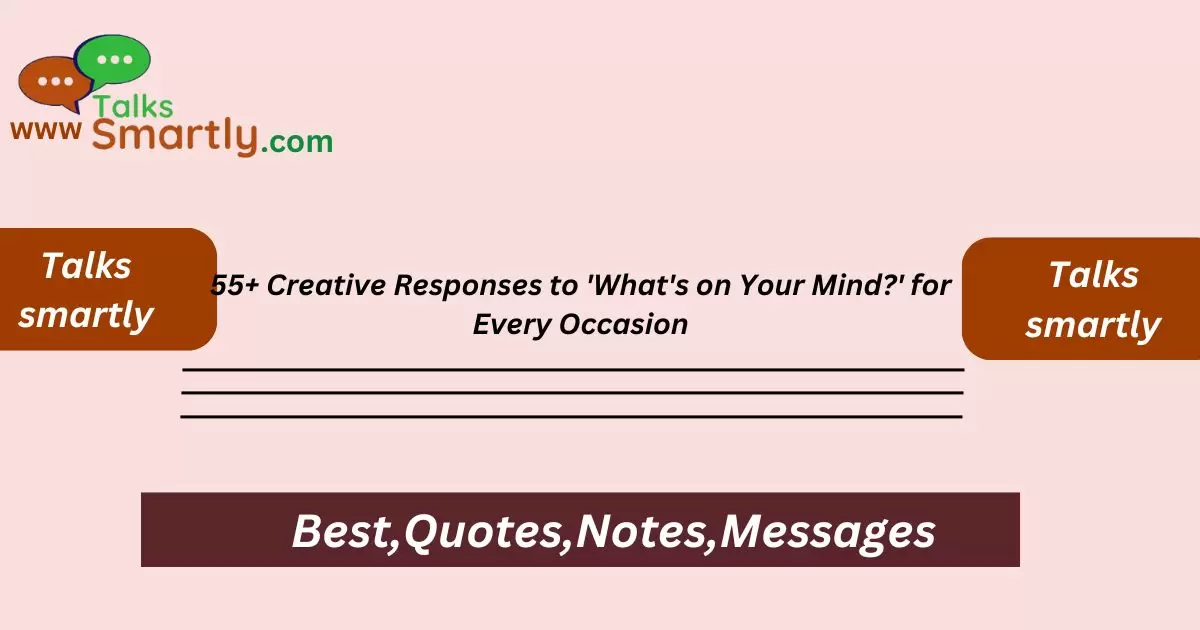“Unlock the art of engaging conversation with over 55 creative responses to “What’s on your mind?” Perfect for every occasion make your memorable and enjoyable.”
Ever find yourself stumped when someone asks, “What’s on your mind?” This simple question can often catch us off guard, making us unsure how to respond in a way that’s both engaging and appropriate for the situation. Whether you’re at a social event, a work meeting, or just chatting with friends, having a variety of creative responses at your disposal can make the conversation more enjoyable and less stressful.
Don’t let the fear of a blank response hold you back. By using these creative and thoughtful replies, you can steer conversations in interesting directions, showcase your personality, and build stronger connections with those around you. Explore these responses to find the ones that best match your style and the context of your conversation.
In this guide, you’ll discover over 55 creative responses to the question “What’s on your mind?” tailored to different settings and occasions.
From witty retorts to thoughtful insights, these responses are designed to make your interactions more lively and engaging. Dive in to find a response that suits your mood and the moment.
Casual Social Gatherings
- Living the dream: “Just living out my wildest dreams, one day at a time!”
- Adventure in the making: “Trying to figure out if today is an adventure or a Netflix day.”
- Musing on life: “Pondering the mysteries of the universe. You know, the usual.”
- Future goals: “Planning my next big move, maybe a new hobby or trip!”
- Exciting projects: “Working on a top-secret project involving pancakes and penguins.”
- Creative brainstorming: “Designing the ultimate playlist for my imaginary road trip.”
- Personal growth: “Reflecting on how I can be a better person every day.”
- Food for thought: “Thinking about what’s for dinner tonight – the eternal question.”
- Dream big: “Dreaming about winning the lottery and what I’d do with it.”
- Current trend: “Trying to decide if I should join the latest TikTok trend or not.”
- Inspirational quote: “Contemplating a quote I read this morning and how it applies to my life.”
- Future aspirations: “Imagining what my life will be like in five years.”
Professional or Work Environment
- Project progress: “Just wrapping my head around the latest project updates.”
- Goal setting: “Focusing on meeting my quarterly goals and targets.”
- Team dynamics: “Considering ways to improve team collaboration and efficiency.”
- Creative ideas: “Brainstorming ideas for our next big presentation.”
- Career development: “Reflecting on my career path and the next steps I want to take.”
- Work-life balance: “Thinking about how to better balance work and personal life.”
- Skill improvement: “Exploring new skills and knowledge to advance professionally.”
- Client relations: “Thinking of strategies to enhance client relationships.”
- Office culture: “Considering ways to contribute to a positive office environment.”
- Upcoming meetings: “Preparing for my upcoming meetings and key discussion points.”
- Innovative solutions: “Contemplating innovative solutions for a current work challenge.”
- Professional networking: “Planning my networking strategy for the next industry event.”
Romantic or Intimate Conversations
- Future plans: “Thinking about our next adventure together and where we should go.”
- Shared dreams: “Imagining the future we’re building together.”

- Emotional check-in: “Reflecting on how we’ve been feeling and what we need from each other.”
- Special moments: “Remembering our favorite moments together and planning new ones.”
- Personal growth: “Thinking about how we can support each other’s personal growth.”
- Creative date ideas: “Brainstorming unique date ideas to keep things exciting.”
- Deep conversations: “Reflecting on what we’ve learned from our deep conversations.”
- Relationship goals: “Discussing our goals and aspirations as a couple.”
- Memorable experiences: “Thinking about the most memorable experiences we’ve had together.”
- Future goals: “Imagining the future and how we see ourselves growing together.”
- Personal feelings: “Contemplating what’s been on my mind about our relationship.”
- Intimate moments: “Reflecting on the little things that make our relationship special.”
Family Gatherings
- Family traditions: “Thinking about our favorite family traditions and how to keep them alive.”
- Upcoming events: “Planning the next big family get-together or celebration.”
- Family memories: “Reminiscing about our funniest or most touching family moments.”
- Personal updates: “Updating everyone on what’s new in my life.”
- Holiday plans: “Discussing our plans for the next family holiday or vacation.”
- Health and wellness: “Reflecting on how we can all stay healthy and happy.”
- Shared interests: “Considering new activities or hobbies we can enjoy as a family.”
- Support system: “Thinking about how we can better support each other.”
- Learning moments: “Recalling important lessons we’ve learned together.”
- Family stories: “Sharing interesting or funny family stories.”
- Future aspirations: “Discussing our hopes and dreams for the future as a family.”
- Family dynamics: “Reflecting on how our family dynamics are evolving.”
Networking Events
- Professional interests: “Exploring the latest trends and innovations in my field.”
- Industry challenges: “Thinking about the biggest challenges facing our industry.”
- New opportunities: “Considering new opportunities for collaboration and growth.”
- Career advice: “Reflecting on the best career advice I’ve received.”
- Personal development: “Contemplating ways to further develop my professional skills.”
- Current projects: “Discussing the exciting projects I’m currently working on.”
- Networking goals: “Setting goals for my networking interactions at this event.”
- Market trends: “Thinking about the emerging trends in the market.”
- Industry insights: “Reflecting on the latest industry insights I’ve gathered.”
- Professional growth: “Contemplating how I can advance in my career.”
- Collaborative opportunities: “Identifying potential collaboration opportunities with other professionals.”
- Event takeaways: “Considering the key takeaways I hope to get from this networking event.”
Casual Conversations with Friends
- Daily life: “Talking about the funny or interesting things that happened today.”
- Hobbies and interests: “Discussing new hobbies or interests I’ve picked up recently.”
- Recent movies: “Sharing thoughts on the latest movie or TV show I’ve watched.”
- Music finds: “Talking about new music I’ve discovered and enjoyed.”
- Book recommendations: “Recommending books that have left a mark on me.”
- Travel experiences: “Sharing recent travel experiences or dream destinations.”
- Personal achievements: “Celebrating recent personal achievements or milestones.”
- Funny anecdotes: “Telling a funny or embarrassing story from my day.”
- Current events: “Discussing interesting current events or news.”
- Fitness goals: “Sharing progress or challenges related to my fitness goals.”
- Social media trends: “Commenting on the latest trends or viral posts on social media.”
- Weekend plans: “Talking about plans or ideas for the upcoming weekend.”
Witty Responses to Being Called a Liar
Educational or Learning Settings
- Course content: “Reflecting on interesting concepts or topics we covered in class.”
- Learning goals: “Considering my goals for this course or learning experience.”
- Research interests: “Discussing areas of research or study that fascinate me.”
- Academic challenges: “Talking about the challenges I’m facing in my studies.”
- Project ideas: “Brainstorming ideas for upcoming projects or assignments.”
- Class discussions: “Reflecting on insights gained from class discussions.”
- Future studies: “Planning what subjects or courses I want to explore next.”
- Learning resources: “Considering additional resources or tools to enhance my learning.”
- Study strategies: “Discussing effective study strategies and techniques.”
- Peer interactions: “Thinking about how to collaborate effectively with classmates.”
- Educational goals: “Setting goals for my academic achievements and progress.”
- Inspirational teachers: “Reflecting on teachers or mentors who have inspired me.”
Social Media Posts
- Creative updates: “Sharing a fun or creative update about my day.”
- Personal milestones: “Posting about recent personal achievements or milestones.”
- Inspirational quotes: “Using an inspirational quote to express my current mindset.”
- Daily highlights: “Highlighting the best part of my day in a post.”
- Photo captions: “Writing a witty or thoughtful caption for a recent photo.”
- Current trends: “Joining in on a trending topic or challenge.”
- Event reflections: “Posting about a recent event or experience.”
- Favorite things: “Sharing my current favorite books, movies, or products.”
- Humor: “Posting a funny or light-hearted update to entertain friends.”
- Personal reflections: “Expressing personal thoughts or reflections on a topic.”
- Future plans: “Sharing exciting plans or goals I’m looking forward to.”
- Daily routines: “Updating followers on an interesting part of my daily routine.”
Professional Development Sessions
- Learning objectives: “Reflecting on the objectives of the professional development session.”
- Key takeaways: “Discussing the key takeaways and insights gained from the session.”
- Skill enhancement: “Considering how the session will help enhance my skills.”
- Networking opportunities: “Thinking about the networking opportunities available.”
- Application of knowledge: “Discussing how to apply the knowledge gained in my work.”
- Feedback and improvement: “Reflecting on the feedback received and areas for improvement.”
- Future training: “Planning future training or development based on what I’ve learned.”
- Professional goals: “Aligning my professional goals with the session’s content.”
- Industry relevance: “Considering the relevance of the session to current industry trends.”
- Actionable steps: “Outlining actionable steps to implement what I’ve learned.”
- Engagement: “Discussing ways to engage more effectively with the content.”
- Mentorship: “Contemplating the role of mentorship in my professional development.”
Spontaneous Interactions
- Random thoughts: “Sharing a random thought or idea that popped into my head.”
- Current experiences: “Discussing something interesting or unusual that happened recently.”
- Surprise plans: “Revealing any spontaneous plans or activities I’ve been considering.”
- Unexpected inspirations: “Talking about an unexpected source of inspiration.”
- Creative ideas: “Exploring a new creative idea that I’m excited about.”
- Life surprises: “Reflecting on any recent surprises or changes in my life.”

- Impulsive decisions: “Discussing any recent impulsive decisions or actions.”
- New discoveries: “Sharing something new I’ve discovered or learned.”
- Exciting news: “Revealing any exciting news or updates I’ve received.”
- Creative solutions: “Talking about creative solutions I’m exploring for a problem.”
- Daily observations: “Commenting on interesting observations from my day.”
- New hobbies: “Discussing any new hobbies or interests I’ve picked up.”
Casual Online Chats
- Virtual adventures: “Talking about my latest virtual adventure or game.”
- Digital trends: “Discussing the latest digital trends or apps I’m exploring.”
- Online interactions: “Reflecting on interesting interactions I’ve had online.”
- Social media finds: “Sharing something cool I found on social media.”
- Virtual events: “Discussing any recent or upcoming virtual events I’m attending.”
- Tech innovations: “Talking about the latest tech innovations I’m excited about.”
- Digital content: “Commenting on digital content I’ve enjoyed recently.”
- Online learning: “Reflecting on online courses or webinars I’m taking.”
- E-commerce: “Sharing thoughts on recent e-commerce experiences or finds.”
- Gaming: “Discussing new games or gaming experiences I’ve had.”
- Digital communities: “Talking about interesting digital communities I’m part of.”
- Virtual connections: “Reflecting on meaningful virtual connections I’ve made.”
Family Meals and Gatherings
- Meal planning: “Discussing the meal plan for the week and any new recipes I’m trying.”
- Family recipes: “Sharing a favorite family recipe or cooking tip.”
- Meal experiences: “Reflecting on memorable meals or dining experiences.”
- Food trends: “Talking about the latest food trends or health tips.”
- Cooking challenges: “Discussing recent cooking challenges or successes.”
- Cultural dishes: “Exploring cultural dishes or cuisines we’re interested in.”
- Family cooking: “Sharing experiences from cooking or baking with family.”
- Favorite foods: “Discussing favorite foods or new food discoveries.”
- Healthy eating: “Reflecting on healthy eating habits or goals.”
- Food-related events: “Talking about upcoming food-related events or festivals.”
- Family traditions: “Discussing family traditions related to meals or holidays.”
- Food stories: “Sharing funny or memorable food-related stories.”
Answer to Key Questions:
1. How can I choose the best response for a given situation?
Consider the context and your relationship with the person asking. Choose a response that matches the tone and setting of the conversation.
2. What if I can’t think of a creative response on the spot?
It’s okay to give a simple, honest answer. You can always follow up with a more detailed or creative response later in the conversation.
3. How do I avoid sounding insincere with creative responses?
Make sure your responses are genuine and reflect your true thoughts or feelings. Authenticity helps in making your responses more relatable.
4. Can these responses be used in professional settings?
Yes, many of these responses can be adapted for professional environments by tweaking them to suit the context and formality of the situation.
5. How can I practice delivering these responses effectively?
Try using them in casual conversations to get comfortable. Practice will help you deliver your responses naturally and with confidence.
Conclusion
Having a repertoire of creative responses for “What’s on your mind?” can transform everyday conversations into engaging exchanges. Whether you’re at a social event, a professional meeting, or a casual chat, these responses offer a way to express yourself in unique and thoughtful ways.












